OnOne's Gigantic Photoshop Add-On
Somehow it just doesn't seem right to refer to OnOne's Perfect Photo Suite as an "add-on". After all, it's a $500 package (currently on sale for $400) that adds framing effects (PhotoFrame), a huge array of photographic effects (PhotoTools), a powerful resizing feature (Perfect Resize), a background remover (Mask Pro), Color Correction (PhotoTune), and even the ability to add bokeh (FocalPoint).
Bokeh? You may have heard the term before. It's the name for the effect that has the primary point of interest in a photograph in sharp focus while the rest of the image is much softer. Film cameras with slow film and long lenses made bokeh easy. Most digital cameras make attaining good bokeh difficult and most point-and-shoot digital cameras make it all but impossible.
PhotoSuite 5.5 (a free upgrade from version 5.0) fixes some problems with the 5.0 release and makes a few additional improvements. Serious amateur photographers and professionals will find these tools to be a worthwhile addition to the digital darkroom.
A WORD ABOUT IMAGES ON THIS SITE
The computer I use has color management software installed. As a result, the images you see on your computer may appear a bit too dark. The image at the right is a color chart that shows various shades of gray from white to black, along with the primary and secondary colors. Click the image to open it and adjust your monitor so that you cad see a difference between the two whitest shades and between the two darkest shades. Your monitor will then be adjusted for optimal photo presentation.
PhotoTools
 I'll start with basic image correction. The photo at the right is of Phoebe. As you can clearly see, it's too dark and rather low in contrast.
I'll start with basic image correction. The photo at the right is of Phoebe. As you can clearly see, it's too dark and rather low in contrast.
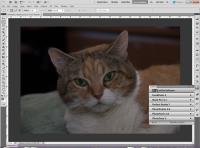 The entire Photo Suite is available from the Photoshop menu, but it can also be placed on a fly-out that makes each of the components readily available.
The entire Photo Suite is available from the Photoshop menu, but it can also be placed on a fly-out that makes each of the components readily available.
 Most of the components offer presets that you can use as is or as a starting point for your own work. This is an example of a preset that converts color images to monochrome. You might think that this would be easy—just desaturate the image—but if you do that, the result will be flat and uninteresting. With PhotoTools, you have the kinds of controls that were available to photographers who used various kinds of films, papers, and developers to achieve the effects they desired.
Most of the components offer presets that you can use as is or as a starting point for your own work. This is an example of a preset that converts color images to monochrome. You might think that this would be easy—just desaturate the image—but if you do that, the result will be flat and uninteresting. With PhotoTools, you have the kinds of controls that were available to photographers who used various kinds of films, papers, and developers to achieve the effects they desired.
 When the monochrome rendition is returned to Photoshop, it is placed in a separate layer so you can easily remove the effect, if you wish, or perform addition modifications such as masking the eyes on the monochrome version so that the color version shows through.
When the monochrome rendition is returned to Photoshop, it is placed in a separate layer so you can easily remove the effect, if you wish, or perform addition modifications such as masking the eyes on the monochrome version so that the color version shows through.
PhotoTune
The color correction module is called PhotoTune and it offers many of the features that you'll find in Adobe Camera Raw. Actually, the number of choices is significantly smaller with PhotoTune, but this makes the modifications easier to understand. There are 4 primary areas of correction: Tone, Color, Skin Tune, and Detail. We'll look at each separately. This image shows what Tone suggested. I liked it, but thought I could do a bit better.
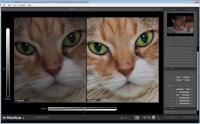 I've made some slight adjustments to the settings and, by zooming in on the image, I can see how the changes improve the image's detail.
I've made some slight adjustments to the settings and, by zooming in on the image, I can see how the changes improve the image's detail.
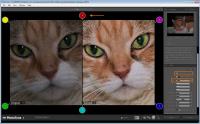 Moving on to the Color tab, I decided to boost red slightly because the cat has a significant red component in her fur. The change is subtle.
Moving on to the Color tab, I decided to boost red slightly because the cat has a significant red component in her fur. The change is subtle.
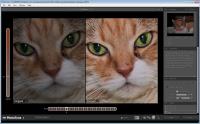 Skin Tune doesn't offer a lot of improvement for a cat because most of the skin is hidden under the fur. I used the eyedropper tool to select a spot on her nose and Photo Tune made a slight correction.
Skin Tune doesn't offer a lot of improvement for a cat because most of the skin is hidden under the fur. I used the eyedropper tool to select a spot on her nose and Photo Tune made a slight correction.
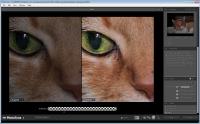 The Detail tab is for sharpening. Most images can use a little bit of sharpening and images that originated from the camera's raw mode almost always need sharpening. It's important to observe this effect at 100% image size.
The Detail tab is for sharpening. Most images can use a little bit of sharpening and images that originated from the camera's raw mode almost always need sharpening. It's important to observe this effect at 100% image size.
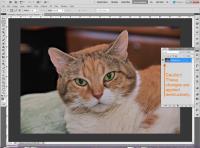 This is a much better image, but notice that by default PhotoTune returns the rendered image as the background and not as a layer on the original image. This is dangerous and should be avoided. In fact, it can be avoided. You need to change the default preference to Apply changes to copy of current layer. In my opinion, that should be the default.
This is a much better image, but notice that by default PhotoTune returns the rendered image as the background and not as a layer on the original image. This is dangerous and should be avoided. In fact, it can be avoided. You need to change the default preference to Apply changes to copy of current layer. In my opinion, that should be the default.
These images appear rougher than they should because, in addition to being slightly over-sharpened, they are reduced to fit on the website. That reduction enhances the sharpening to the detriment of the images.
PhotoFrame
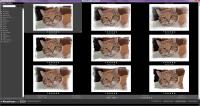 Maybe you'd like to put a frame around your image or add a burnt-edge effect, torn-paper effect, or one of the other treatments that you'll see in professional publishing and in scrapbooking. The PhotoFrame component has what appears to be hundreds of presets and each preset can have many of its settings modified.
Maybe you'd like to put a frame around your image or add a burnt-edge effect, torn-paper effect, or one of the other treatments that you'll see in professional publishing and in scrapbooking. The PhotoFrame component has what appears to be hundreds of presets and each preset can have many of its settings modified.
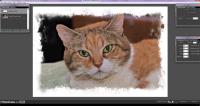 I selected this basic acid burn effect and then started exploring the four areas that can be modified: Background (opacity, blur, noise, size, orientation, and color), Border (opacity, blur, noise, width, interior color, and exterior color), Color (inner and outer glow, radiance, opacity, noise, and width), and Shadow (opacity, blur, noise, inner and outer color, vertical offset, and horizontal offset).
I selected this basic acid burn effect and then started exploring the four areas that can be modified: Background (opacity, blur, noise, size, orientation, and color), Border (opacity, blur, noise, width, interior color, and exterior color), Color (inner and outer glow, radiance, opacity, noise, and width), and Shadow (opacity, blur, noise, inner and outer color, vertical offset, and horizontal offset).
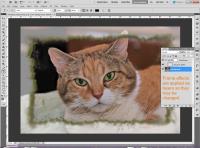 I made some changes, including adding some of the green from Phoebe's eyes to the outline. I also changed the opacity a bit and blurred the background.
I made some changes, including adding some of the green from Phoebe's eyes to the outline. I also changed the opacity a bit and blurred the background.
By default, PhotoFrame applies its effects as a layer mask so they can be modified or removed later.
 And here's the final framed Phoebe.
And here's the final framed Phoebe.
There's no bottom line ... yet.
PhotoSuite 5.5 is simply too large to cover in a single program, so I'll continue this review of the application's features next week.
In the meantime, if you want to see more, visit OnOne Software's website.
See part 2 of the TechByter review.
Is Firefox 4 Beta 11 for You?
You're supposed to hold the answer to the question until the final sentence of the last paragraph, but I'll answer it right here: Probably not. There's nothing wrong with Firefox 4, but using beta software carries some baggage that you might not want to store.
I can say that version 4 is going to be one great release and I'll share with you some of the features in the new version. The problem with the beta version is that it will (not "might", but "will") break some of your add-ons. You can work around this problem with the Nightly Tester Tool add-on that forces add-ons to ignore the Firefox version and doing so will allow your favorite add-ons to work much of the time. But not all.
Some add-ons will just fail silently. Others might crash Firefox. If you really depend on specific add-ons, this could be a concern. For example, I use Symantec's Identity Safe to supply user names and passwords for many sites. Even though the Nightly Tester Tool has forced it to be compliant, it doesn't work at all in beta 4. This isn't a problem because I've stored important information elsewhere, but it's a minor annoyance.
And although Firefox is currently at its 11th beta, there's no guarantee that the final code will be released anytime soon. In fact, the Mozilla website goes to extreme measures not to mention any specific date. It could be next week. It might be in 2017. (Probably closer to next week than to 2017, though.)
The new version will have a "Do Not Track" option. Visit the Advanced tab on the Options screen and click Do Not Track if you're worried about being tracked by sites. This causes Firefox to send an opt-out message in the HTTP request header to tell sites you don't want to be tracked. Of course, this depends on sites both understanding the message and complying with it, so it may be more theater of security (think TSA) than real security.
Mozilla Privacy Lead Alex Fowler defends the practice and calls it the first of many steps that are under consideration. "We believe the header-based approach has the potential to be better for the Web in the long run because it is a clearer and more universal opt-out mechanism than cookies or blacklists."
Tab Candy is another new feature. Aza Raskin, a Firefox developer, says "It's hard to keep everything straight with dozens of tabs all crammed into a little strip along the top of your browser. Your tab with a search to find a pizza parlor gets mixed up with your tabs on your favorite band. Often, it's easier to open a new tab than to try to find the open tab you already have. Worse, how many of us keep tabs open as reminders of something we want to do or read later? We're all suffering from infoguilt. We need a way to organize browsing, to see all of our tabs at once, and focus on the task at hand. In short, we need a way to get back control of our online lives."
Here's more information from Aza Raskin:
You'll find lots of user interface changes. For some reason, the home page icon is now near the far right edge of the browser and it took me a while to find it. Users may choose to keep tabs where they were or to move them to the top. I moved the tabs to the top and that seems to be exactly the right place for them to be.
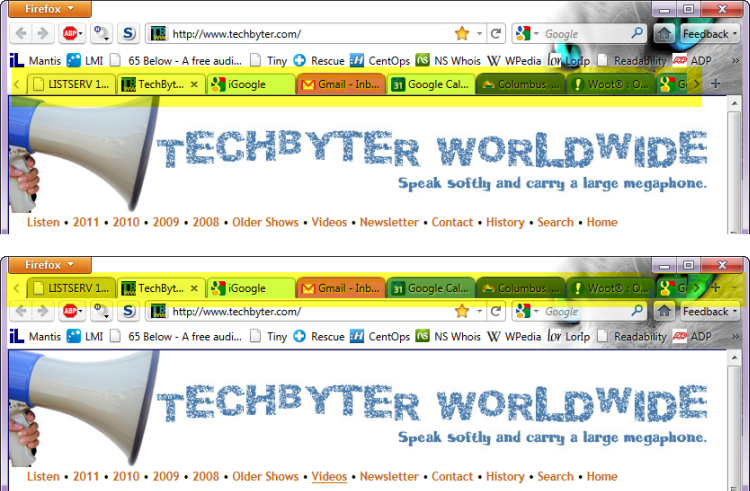
If you're interested in downloading the beta version (keeping in mind the warning that some features won't work as expected), you find Firefox version 4 beta here.
A new version of Microsoft's Internet Explorer (version 9) will be released soon, too, and the betas have received excellent reviews. If you're using a version of Internet Explorer 7 or earlier, Firefox 2 or earlier, any version of Netcape, Opera 10 or earlier, Chrome 8 or earlier, I have just one question for you: WHY???
Short Circuits
Worth Watching
You've probably heard these numbers before: Radio needed 38 years to reach 50 million users. Television took 13 years to do that. The Internet hit 50 million users in 4 years. In 3 years, Apple sold 50 million Ipods. Facebook? They added 200 million users in less than 1 year. Radio was considered "a fad". Television was considered "a fad". The Internet was considered "a fad". So was the Ipod. You may have noticed a trend here. With that, I recommend a YouTube video.
The video is approximately 4½ minutes long and some of it may surprise you. If you don't care for the audio, just kill the sound. The text is all you need. That and, according to the Beatles, love.
The Greedy Apple Takes a Bite out of Journalism
Apple's Ipad, despite the goofy name, was supposed to be something that could be used to distribute work by journalists—newspapers, magazines, and the like. Then Apple announced the details. Apple will take a THIRTY PERCENT CUT of subscriptions. For what? This is insane! Five percent, fine. Ten percent, maybe a little pushy, but OK. Fifteen percent, ridiculous. And THIRTY percent? Obscene.
Forbes Magazine's Jeff Bercovici explains the problem. Journalism's business model depends on advertisers to foot most of the bill while requiring very little from the users of the media. Publishers offer cheap subscriptions ($10 or $12 per year) to attract new subscribers. This is, in some cases, less than the cost of postage for a year but publishers realize enough renewals at full price to make the introductory offers worthwhile.
In addition to taking a 30% cut, Apple insists that publishers include their best offers to Ipad subscribers.
(Opinion alert!) This heightens my belief that while Apple might be a company that creates some outstanding products, it is not a company that I would care to work for. It tends to be greedy and it doesn't even treat its own customers very well.
According to Steve Jobs, "Our philosophy is simple—when Apple brings a new subscriber to the app, Apple earns a 30 percent share; when the publisher brings an existing or new subscriber to the app, the publisher keeps 100 percent and Apple earns nothing. All we require is that, if a publisher is making a subscription offer outside of the app, the same (or better) offer be made inside the app, so that customers can easily subscribe with one-click right in the app. We believe that this innovative subscription service will provide publishers with a brand new opportunity to expand digital access to their content onto the iPad, iPod touch and iPhone, delighting both new and existing subscribers."
Amazon will have a competitive answer. So, perhaps, will others. How all this will play out is still open to question, but it certainly doesn't seem that Apple is doing its fans or journalists or publishers any favors. Should that surprise anybody?
A 16GB Thumb
In the late 1990s, I encountered my first thumb drive at PC Expo in New York City. Offered by an Israeli company, the device allowed anyone to carry 16MB of data (more than a dozen floppy disks!) in a device no larger than a thumb. Cost: About $50. This week I bought a 16GB thumb drive for about $22 (including shipping). A day later, I saw an ad for a 32GB thumb drive for just $10 more.
The 16GB drive is 1000 times more memory at half the price of the original devices. This kind of pricing is normal for electronic devices, particularly for hard drives and now for solid-state devices, but that doesn't make the difference any less breathtaking: In effect, the price for some devices is now just a fraction of one percent of what it was just a decade ago.
Solid-state disk drives are approaching the point at which they will really be competitive with standard hard drives. Solid state drives are faster, less prone to vibration-caused damage, lighter, and smaller.
What's left to say other than WOW!

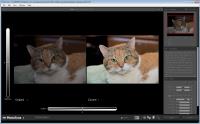


 The author's image: It's that photo over at the right. This explains why TechByter Worldwide was never on television, doesn't it?
The author's image: It's that photo over at the right. This explains why TechByter Worldwide was never on television, doesn't it?
